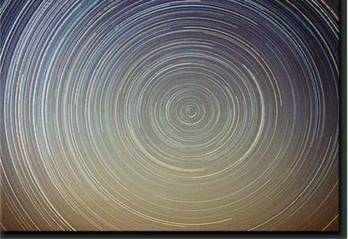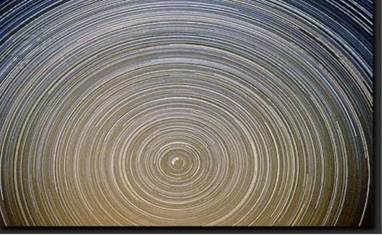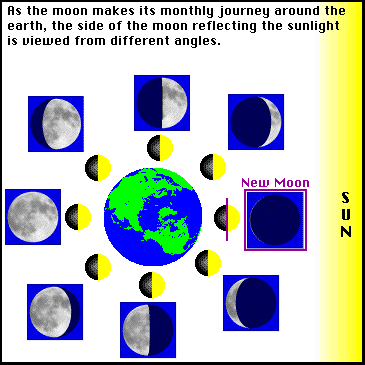
The Moon and the Earth
Unit
Overview
Welcome! In this unit we will discuss the rotation of the
earth and why we have day and night and also the paths of the earth and moon
and how they affect each other.
You can go back and look at the earth in the last unit and at
the moon at many of the websites that are listed there. Look closely at the
earth and moon and also at how the earth looks in comparison to the sun. You
should already have learned from previous science courses that the earth is a
spinning ball. Turning around a center point, or turning on an axis, is called rotation.
A record rotates around its center on a turntable. The front or back wheels of
a car rotate around a rod or axle. A pencil or knitting needle through the
center of a ball is an axis on which the ball can turn. The earth turns too,
just like a ball between your fingers. The earth’s axis, which is tilted about
23.5 degrees, is an imaginary line through its center called the axis of rotation.
This spinning on its axis causes the

South Celestial Pole
These centers, projected into the sky, are called the north
celestial (sell-ESS-chill) pole and the south celestial pole.
“Celestial” means heaven or sky. The places on the earth directly under the
north and south celestial poles, where the axis goes through the surface of the
earth, are called the geographic poles. Looking down at the North Pole
you would see that the earth rotates counterclockwise around its axis. You are
traveling with the earth around the sun at an average speed of 106,000 km/hr.
The movement of the earth around the sun is called revolution. Each
complete revolution takes 365.24 days, or 1 year.

North Celestial Pole
Now let’s talk about time. Have someone in your house help
you with this. Put your head down, close your eyes, and estimate how long three
minutes is. When you think three minutes is up, raise your hand. Have the other
person watch the clock to check to see if you are close. Do it again and see if
you get closer or are further away from estimating three minutes. What
determines time? How do you measure time if you do not have a watch?
As the earth rotates counterclockwise from east to west in 24
hours, half of it is in sunlight and half is in darkness.
Here is an activity to help you understand night and day with
how the earth rotates. You will need one person to help you with this activity.
You can be student number one or student number two, and the person working
with you can be the other student.
Common Misconceptions
One problem with trying to understand the concept of day and
night (as well as some other basic concepts of astronomy) has to do with
"frames of reference." Most textbooks show the cause of day and night
(the rotation of the Earth) as would be seen by an outside observer, far from
the Earth. You need to also see it from your own perspective, as a person
standing on Earth. Activity #1 has
been designed to help clear up this misconception

Background Information
It is the rotation of the Earth that causes day and night
The Earth rotates counterclockwise; thus a person standing on
Earth sees the Sun rise in the East and set in the West. The Earth rotates
toward the East and so, to the people on Earth, it looks like the Sun is moving
towards the West when, in fact, it is the Earth that is moving. A good metaphor
for this is the merry-go-round. When you’re riding on it and look out at the
people standing on the ground, it looks as if they are moving, but in fact,
you’re the one who is moving.
The Earth rotates on its axis once every 24 hours and takes
about one year (365 days) to revolve around the Sun.
Activity #1 Day And Night Thanks To the Rotating
Earth developed
by John Percy Time: 40
minutes
Materials
1.
Two large index
cards - write EAST on one and WEST on the other inwriting large enough for your
audience to see
2.
Orange card with
the word
3.
Two regular-sized
index cards per pair of students and tape
4.
Follow-up
activity requires a globe and a light source
Instructions
This activity has been designed to
help students and adults learn the about the difficult concepts of day and
night, sunrise and sunset.
You need someone to help you
demonstrate the activity. Student #1 is
the Sun (this student can hold a large orange cloth or construction paper, or a
sign that says SUN). Student #2 is
the Earth. The Earth holds WEST card in right hand, EAST card in left hand.
This is the correct orientation if you are facing south.
You can tape a sign on the front of
the student to represent the city you’re in. On the student’s back, tape the
name of a city whose time difference is about 12 hours from your city, but in
the Northern Hemisphere. For example,
Have Student #2 face the Sun and turn in slow motion counterclockwise
because that's the direction that the Earth rotates, when seen from the
northern hemisphere.
Optional: you can say this chant as
the Earth turns:
Ickly, pickley, paxis
The Earth spins on its axis
Ishkey, pishkey, pight
It turns from day to night.
Note: the Sun
student can also rotate: the Sun rotates in the same sense as the Earth, but in
about 30 days.
Ask Student #2 (Earth) to call out when the Sun is setting, when it is
night and when it's rising on that city (e.g.,
If you want precision, stop the Earth
student at 90° intervals and ask what time of day it is in the chosen city at
each of these stops.
If you have a globe you can go into a fairly dark room with a
flashlight and shine it on the globe and see how the light only lights up part
of the earth and as the earth rotates different parts of the earth become light
while other parts become dark. As the globe turns, see how the sunset comes and
the night falls on the side of the globe opposite the sunrise.
Major Points
§ As time passes, things happen.
§ Time is measured by clocks in units
of hours, minutes, and seconds.
§ While the earth is rotating, the moon
is revolving around the earth. People have always enjoyed looking at the moon
and wondering about it. They have written songs and poems about the moon.
Ancient people thought there must be human beings living on the moon. They also
imagined many strange moon people or fearsome beasts on the moon’s bright
continents and its dark seas. And always the man in the moon, imagined by those
bright and dark regions on the moon’s face, looked down at us on earth. Soon
after telescopes were invented, astronomers began to map the moon. They
discovered squares and triangles they thought were cities. They even saw a
long, straight line they named and called the
§ In modern times, of course, astronomers did not believe people built the Straight Wall. With modern technology, we all know what is up on the moon.
The mass of the moon is only 1/80 that of the earth, and the
fact that the earth rotates on an axis causes the moon to appear to rise and
set. Go out and see what time the moon rises and sets for 2-3 days in a row.
You should notice that the moon rises 50 minutes later each night. The moon
also spins on its axis very slowly. It completes one complete rotation during
each orbit around the earth. The moon also rocks slightly on its axis and this
makes it possible to see 59% of the moon’s surface. Because of the moon’s
rotation around the earth, we get solar eclipses. A solar eclipse is
when the sun’s light is completely blocked out by the moon. A lunar eclipse
is when the earth is blocking the sun, and the moon is completely in the
earth’s deep shadow called the umbra.
The moon appears in different shapes. These different shapes
are called the phases of the moon. The phases of the moon are:
|
New Moon - The Moon's unilluminated side is facing the Earth. The
Moon is not visible (except during a solar eclipse). |
|
Waxing Crescent - The Moon appears to be partly, but less than one-half,
illuminated by direct sunlight. The fraction of the Moon's disk that is
illuminated is increasing. |
|
First Quarter - One-half of the Moon appears to be illuminated by direct
sunlight. The fraction of the Moon's disk that is illuminated is increasing. |
|
Waxing Gibbous - The Moon appears to be more than one-half, but not
fully, illuminated by direct sunlight. The fraction of the Moon's disk that
is illuminated is increasing. |
|
Full Moon - The Moon's illuminated side is facing the Earth. The
Moon appears to be completely illuminated by direct sunlight. |
|
Waning Gibbous - The Moon appears to be more than one-half, but not
fully, illuminated by direct sunlight. The fraction of the Moon's disk that
is illuminated is decreasing. |
|
Last Quarter - One-half of the Moon appears to be illuminated by direct
sunlight. The fraction of the Moon's disk that is illuminated is decreasing. |
|
Waning Crescent - The Moon appears to be partly, but less than one-half,
illuminated by direct sunlight. The fraction of the Moon's disk that is
illuminated is decreasing. |
Following waning crescent is New Moon, beginning a repetition
of the complete phase cycle of 29.5 days average duration. The time in days
counted from the time of New Moon is called the Moon's "age." Each
complete cycle of phases is called a "lunation."

The sun and the moon together make tides, the rising and
lowering of water levels on earth. The moon’s gravitational pull is about 2.4
times that of the sun because the moon is so much closer than the sun to the
earth. At high tide, the moon makes the water bulge up in the oceans on the
side of the earth facing the moon.